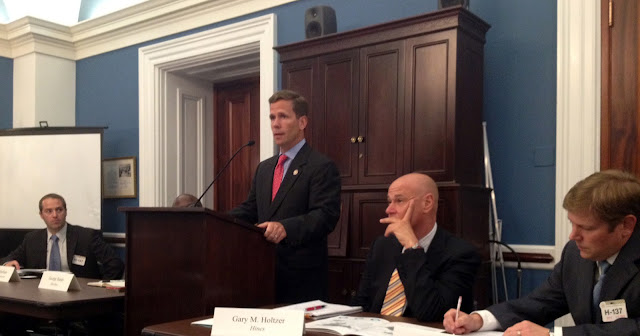 Bryan Howard
Bryan Howard
Legislative Director
U.S. Green Building Council
LEED for Business: No, it’s not a new rating system – but rather, the pulse of every LEED rating system. LEED has become an instrumental tool for businesses, from commercial construction companies to global financial firms to your favorite coffee shop. Forty-eight companies in the Fortune 100 use LEED certification to reduce operating and energy costs, and nearly 1,300 product manufacturers are USGBC members. Why? As USGBC’s Vice President of National Policy, Jason Hartke, put it, “The business case for LEED is unassailable.”
This afternoon, three key LEED users, from Hines, Interface, and Yates Construction – came to the Capitol to talk business: Why they use LEED and how it impacts their business operations.
Congressman Robert Dold (R-IL), co-chair of the Congressional Green Schools Caucus, kicked off the event with a nod to green building practices.
 |
| L to R: Mason Statham of Yates Construction, Congressman Dold, Gary Holtzer of Hines, and Jason Hartke, USGBC |
“I’ve been talking to businesses everyday about removing overhead costs,” said Dold. “I’ve seen solution after solution that pay themselves off after 18 months. Certainly, we need to follow suit with government buildings.
“I think this is a very important topic and one we’re going to hear a lot more about.”
And that we did.
“What it does is create passion.”
Gary M. Holtzer, managing director and global sustainability officer at Hines, described LEED as a vehicle that “…allows you to start to think about the broader picture of what sustainability means.” He added later, “Seventy percent of the world’s population will be living in cities by 2050. We are a firm that wants to be forward thinking about sustainability now.”
But the real importance of LEED? “What it does is create passion.”
To underscore this point, Holtzer told the story of 101 California, a LEED-certified building and Hines project in San Francisco. The project was ranked at the Certified level on April 14, 2009.
“The operating engineers decided that wasn’t good enough,” Holtzer said. “They wanted Platinum to prove that they ran a good building.”
The culmination? The 30-year-old 101 California building took a second go at LEED and earned Platinum last July – becoming the highest scoring existing building project awarded at that time.
“It’s profitable for us.”
 |
| George Bandy Jr., of Interface |
As George Bandy Jr., Vice President of Interface, spoke about his company’s commitment to sustainability (pioneered by corporate sustainability legend Ray Anderson), he pointed to the floor.
“At this very day we can take this carpet tile on this floor and re-manufacture it in to new carpet.” He added, “And it’s profitable for us.”
Bandy noted that transparency and corporate responsibility have always been foundational elements of the Interface brand, and sustainable operations have been a key way to emphasize that.
“It’s no longer okay to privatize wealth and socialize the risk.”
“It’s created markets and supported business.”
Mason Statham, Director of Sustainability for Yates Construction, said the interest in LEED is “…owner-driven. We work for owners and investors. We build what they want, and what they see is a good investment. It creates a competitive advantage.”
What’s more, Statham said, is that LEED has “…created markets and supported business.”
To exemplify this point, Statham recalled working on the Keesler Air Force Base LEED for Homes project in Mississippi – the largest LEED for Homes project in history. His team was pursuing sustainable construction waste management, but faced difficulties when they realized local waste facilities and vendors did not provide sustainable services. So Statham’s team began asking local vendors to provide this option.
Two years later, when Statham’s team returned to this market to work on another LEED project, the infrastructure had been built out and local businesses were offering construction waste management services.
“All the sudden, this service existed. [LEED has] created markets and supported business.”
“It’s pushing technology.”
Holtzer, of Hines, closed out the briefing after a Q & A session.
His final anecdote touched on Hines’ relationship with LEED, of which he noted, “We don’t always agree with USGBC.” But disagreements lead to dialogues, which ultimately lead to innovation. Specifically, Holtzer noted that many investors and clients request building spaces with floor to ceiling windows, often conflicting with green building strategies. In seeking solutions, innovation occurs: Windows that transition from transparent to shaded based on how much daylight the building is receiving, or glazes that mitigate the effects of UV rays and heat.
“The buildings that do not continuously improve will be left behind…[LEED] is pushing technology. Without this push/pull dialogue, it may not happen as quickly – and we want it to happen quickly, because it’s good for all of us.”








